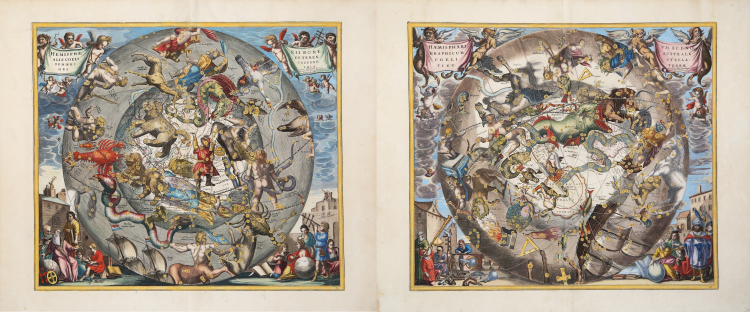







| Reference: | S43180 |
| Author | Andreas CELLARIUS |
| Year: | 1660 ca. |
| Zone: | Celestial Chart |
| Measures: | 495 x 435 mm |






| Reference: | S43180 |
| Author | Andreas CELLARIUS |
| Year: | 1660 ca. |
| Zone: | Celestial Chart |
| Measures: | 495 x 435 mm |
A nice pair of celestial charts from Atlas Coelestis Seu Harmonia Macrocosmica del Cellarius, first published by Janssonius in 1660.
His connection with the Janssonius publishing firm dates from around 1645. In this year Jodocus Janssonius, Johannes’s son, published Cellarius’s Architectura Militaris, a work on fortifications. In 1652 the Amsterdam publisher Gillis Jansz. Valckenier published Cellarius's Regni Poloniae … with 21 maps.
In 1660, Joannes Janssonius added a celestial atlas to his Atlas Major, the beautiful Harmonia Macrocosmica by Andreas Cellarius. In 1661 the atlas was republished as a separate publication. The plates of the Harmonia Macrocosmica were reprinted (without the Latin commentary) in 1708 by the Amsterdam publishers Valk and Schenk.
The Harmonia Macrocosmica is the most beautiful celestial atlas ever published and is one of the notable masterworks from the Golden Age of Dutch cartography. The first part of the atlas contains engravings depicting the world systems of Claudius Ptolemy, Nicolaus Copernicus, and Tycho Brahe. At the end are star maps of the classical and further constellations.
Andreas Cellarius was born in 1596 in Neuhausen and educated in Heidelberg. He emigrated to Holland in the early 17th century, and in 1637 moved to Hoorn, where he became the rector of the Latin School. The work consists of a series of Celestial Charts begun by Cellarius in 1647 and intended as part of a two-volume treatise on cosmography, which was never issued.
Cellarius' charts are the most sought after of celestial charts, blending the striking imagery of the golden age of Dutch Cartography with contemporary scientific knowledge. The present examples come from the Valk & Schenk edition of Cellarius' atlas, which is unchanged from the 1661 edition. The 1660 and 1661 editions can be distinguished by the inclusion of a plate number in the lower right corner of the 1661 edition. The Valk & Schenk edition can be distinguished by the addition of the printer's name (Valk & Schenk) in the titles of the maps.
Magnificent proofs, printed on contemporary laid paper, finely hand-colored, with full margins, in good condition.
Andreas CELLARIUS (Neuhausen, c. 1596 – Hoorn, 1665)
|
The Dutch-German mathematician and cosmographer Andreas Cellarius is well known to map historians and historians of astronomy as the author of the Harmonia Macrocosmica, commonly regarded as one of the most spectacular celestial atlases that was published in the second half of the seventeenth century.
The Harmonia Macrocosmica was published in 1660 (a reprint was issued in 1661) by the Amsterdam publisher Johannes Janssonius as a supplement to his Atlas Novus. Cellarius had already started working on this atlas before 1647 and intended it to be a historical introduction for a two-volume treatise on cosmography but the second part was never issued. Cellarius resigned as rector in early 1665 and died in November on the same year. The plates of his Harmonia Macrocosmica was reprinted (without the Latin commentary) in 1708 by the Amsterdam publishers Gerard Valk and Petrus Schenk.
|
Andreas CELLARIUS (Neuhausen, c. 1596 – Hoorn, 1665)
|
The Dutch-German mathematician and cosmographer Andreas Cellarius is well known to map historians and historians of astronomy as the author of the Harmonia Macrocosmica, commonly regarded as one of the most spectacular celestial atlases that was published in the second half of the seventeenth century.
The Harmonia Macrocosmica was published in 1660 (a reprint was issued in 1661) by the Amsterdam publisher Johannes Janssonius as a supplement to his Atlas Novus. Cellarius had already started working on this atlas before 1647 and intended it to be a historical introduction for a two-volume treatise on cosmography but the second part was never issued. Cellarius resigned as rector in early 1665 and died in November on the same year. The plates of his Harmonia Macrocosmica was reprinted (without the Latin commentary) in 1708 by the Amsterdam publishers Gerard Valk and Petrus Schenk.
|